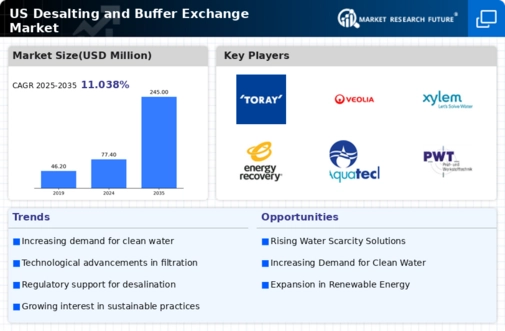The US Desalting and Buffer Exchange Market is characterized by an increasing demand for advanced separation technologies, specifically in the context of water treatment solutions. As the need for fresh water grows and the pressure on conventional water sources mounts, several players are strategically navigating this market, focusing on innovative techniques and high-quality products. The competitive landscape is driven by factors such as technological advancements, the rising awareness of water scarcity, and stringent regulations related to water quality.
Companies are leveraging their manufacturing capabilities and R&D investments to develop cutting-edge desalting membranes and buffer exchange technologies that optimize performance and circumvent limitations typical of traditional methods. As new entrants emerge, established firms are enhancing their market presence by forming partnerships and investing in regional growth opportunities, which further intensifies competition.
Hydranautics
Hydranautics has solidified its status as a leader in the US Desalting and Buffer Exchange Market by showcasing a robust portfolio of advanced membrane technologies aimed at desalination and water purification. The company's strengths lie in its innovative research capabilities and commitment to high-quality products, which have enabled it to meet the growing demands of the market efficiently.
Hydranautics' dedication to sustainability and the environment enhances its appeal to clients seeking eco-friendly solutions. Their extensive experience in the industry facilitates the development of customized offerings for specific applications, enabling them to maintain a strong competitive edge. With a well-established distribution network and longstanding relationships with key stakeholders, Hydranautics continues to capitalize on the burgeoning demand for desalting solutions across various sectors within the United States.
Nitto Denko Corporation
Nitto Denko Corporation has also made significant strides in the US Desalting and Buffer Exchange Market, showcasing its commitment to innovation and quality through a range of advanced products and services. This company harnesses its expertise in polymer technologies to develop high-performance membranes that cater to the specific needs of the desalination sector.
With a strong market presence in the United States, Nitto Denko Corporation has consistently invested in research and development, which has led to innovations aimed at enhancing membrane efficiency and durability. The company has pursued strategic mergers and acquisitions to broaden its product portfolio and improve its competitive positioning, allowing it to tap into emerging market opportunities effectively. By emphasizing a customer-centric approach and offering tailored solutions, Nitto Denko Corporation reinforces its reputation as a reputable provider of desalting technologies in the US, contributing significantly to the ongoing evolution of the water treatment landscape.

















Leave a Comment